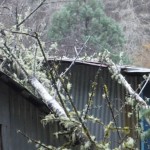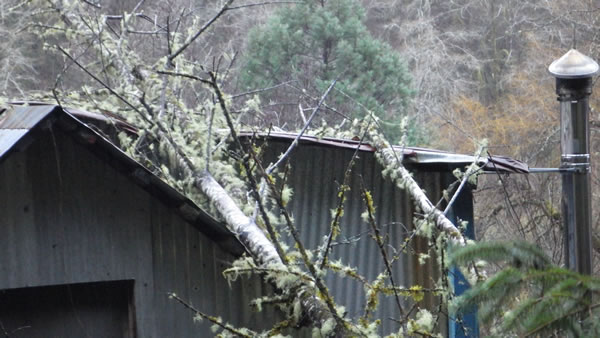By Carol van Strum
Future archaeologists poring over the remains of our humble dwelling will discover a remarkable phenomenon. At exactly sunrise on the winter solstice, on the rare occasions when the Sun appears at all at this time of year, the sunlight pierces a small hole just below the roof peak. For precisely eight minutes, a broad sunbeam illuminates a wall of faded Red Dwarf stills, ending its bright passage on a sheet of 32-cent Comic Strip Classics postage stamps.
The geographic precision of this solar alignment with a minor flaw in exterior siding will no doubt have future anthropologists drooling, but their interpretations will be far off the mark. Even farther off are any religious or ritual connotations they might attribute to this annual spotlight on Lister, Rimmer, the effervescent Cat, and other Red Dwarf regulars, to say nothing of the perforated portraits of Popeye, Nancy, Dick Tracy, Blondie, Alley Oop, Krazy Kat, Barney Google and Prince Valiant.
To avoid such future misinterpretations, I hereby certify that the aforementioned hole in the siding was not intentional and has no astronomical or mythical connotation, being instead the result of a stage carpenter’s hapless attempt to build a real live house. The Red Dwarf photos lit by the solstice sunbeam are no more than my son’s exuberant experiments with early downloading software, our first color printer, and a tube of superglue. And the postage stamps? That’s a tough one to explain without revealing an entire family’s inability to tear a single comic hero from the glorious bunch.
So much for the solstice, which in these parts is just another grey winter day. The day worth celebrating is not December 21, but December 26, and no direct Sun is needed. The 26th, you see, is the day the chickens notice the extra minute and a half of daylight and respond accordingly.
In our supreme arrogance, we think we’re smarter than chickens and other bird-brains, but if the Sun didn’t appear to “stand still” for a few days as Earth tilted on its axis, I doubt if we humans would notice the lengthening days until mid-January or even February, the increase is so minimal at first. But the chickens notice almost immediately; within five days of the solstice, the hens rearrange the tired straw in their nests and start gobbling oyster shell, kale, and other sources of calcium; after lazing around for months, their stud rooster stocks up on worms and protein, oils up his crow for another season of strenuous, nonstop sex, and wakes the world at first light again.
By December 26, the changes are apparent: after only one or two eggs per day since mid-October, the number increases daily, at first punctuated by occasional “practice eggs” — huge double or triple yolkers, tiny yolkless wonders, and more rarely shell-less, wobbly membranes like jelly balloons, bulging with precious cargo. By mid-February, each hen is producing an egg almost every day.
Chickens are not the only birds that respond to minute changes in day length after solstice. Certain owls, for instance, build their nests in this dead-time of winter and lay their eggs while the world sleeps under blankets of snow. I’ve never eaten owl eggs, however, and chickens are easier to observe than owls. An important distinction is that these are not commercially-raised battery hens, living out their short, beakless lives under artificial lights without ever seeing the Sun or sky or seasonal changes in daylight, and never even dreaming of a rooster; their life span is measured in months. The chickens here are farmyard critters, with their own raccoon-proof house and yard, and access to unlimited greenstuff and bugs; their lives follow the seasons and so does their egg production.
Long ago, I tried installing lights in the chicken house and keeping it lit during the winter, which ensured constant high egg production through the year, but the hens only lived for a year or two, and I took the lights out; the oldest of our hens since then have lived fifteen years or more, some laying eggs seasonally right up to their last year before enjoying a well-deserved retirement. In return for our protection and care, they provide not only eggs but rich, organic manure for the garden, which in turn produces much of their greenstuff and many worms. Come winter, egg production shrinks with the shortening days and we turn to egg-less recipes, which makes December 26 a day to anticipate and celebrate:
Love and joy come to you
And to you an egg or two…



Carol, thank you so much – I got a good chuckle from this. (And Red Dwarf is an all-time favourite.)
Reminds me of “The Egg and I” by Bette MacDonald, Carol. Thank you for that, and an eggstra-special Boxing Day to you and all your hens.
Solstice blessings – and beyond!
GRAND old movie, Geoff — I love that the world was like that once … with that level of courtesy and affection, even among ‘strangers.’ Not necessarily an easier time, but a less hostile one, I think. Thanks for re-membering that for me! And a lovely Boxing Day to you as well!
Hugs
Jude
I’m hoping you lost nothing irreplaceable when the trees came down, Carol — and that there is a fix at hand that won’t displace you. And I love the story about the geriatric chickens … that’s just the BEST! ( I was going to say eggcellent, but … ) Sending good thoughts your way and affirmations of synchronicities to mend everything quickly!
Carol van Strum just sent this reply via email:
Lovely piece, & took me back to childhood on an isolated, non-modern small farm – complete with chickens – yes, they & other creatures have great wisdom & sensitivity – yes, they would respond to the change in the light. And oh, how I enjoyed watching them – chicken talk/socializing is fascinating.
Thanks for taking me back there on this grey Solstice morning. I got up for sunrise, but all I could see was a wall of frosted fog.
Thanks for this wonderful article! I used to raise chickens and have so many stories and great memories. When I was a third grade teacher, I would start the first day of school by asking students, “Where does the chicken you eat come from!” You can teach and learn so much from the hen house!
Happy Holidays to you!